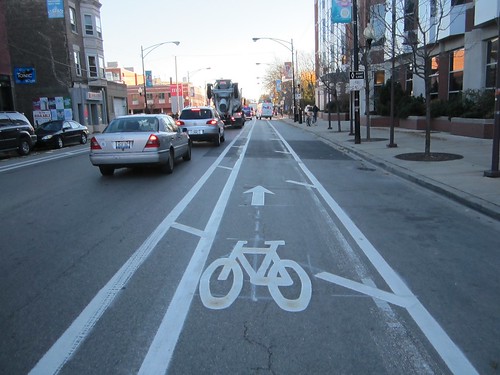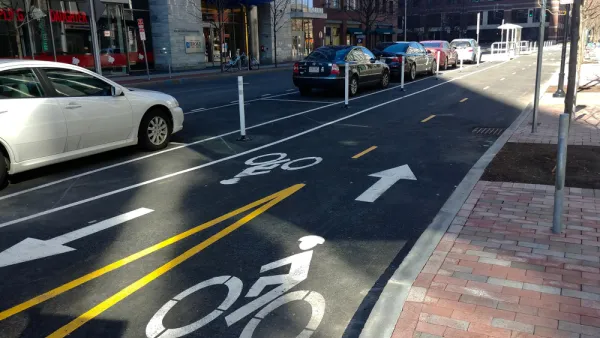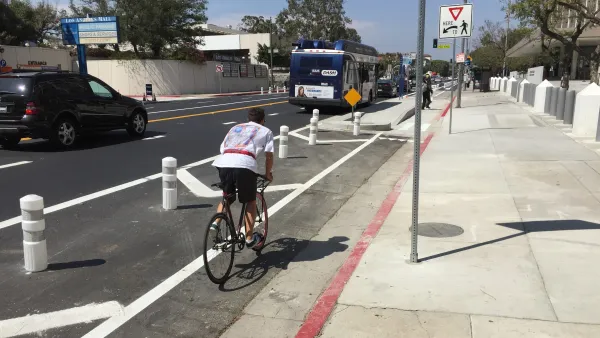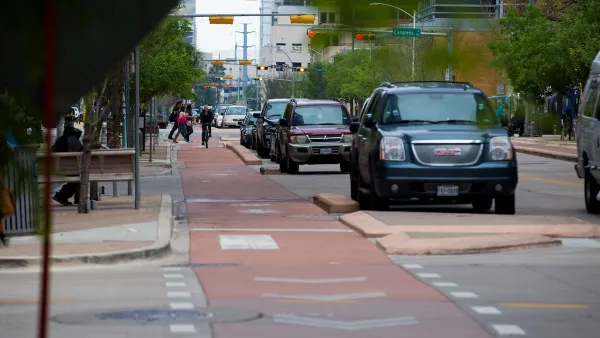What's the best street design to keep bicyclists safely out of the door zone? A buffered bike lane beats a conventional bike lane or "wide curb lane" according to a recent study published in TRB, based on observations in Chicago and Cambridge, Mass.
"Dooring", whereby the bicyclist rides too close to a parked vehicle and becomes vulnerable to crashing should a car door be flung open, can be avoided by biking a safe four feet away from the parked vehicle, but that's easier said than done, particularly on narrow "curb" lanes. But new research shows that even when riding in standard bikes lanes or wide curb lanes, the vast majority of cyclists continue to bike in the door zone.

WIDE CURB LANE
"A wide curb lane is the traffic lane next to the curb (the right most lane) which is extra wide so a motorist can safely pass a bicyclist without having to change lanes. There is no line painted on the street separating motorists from the bicyclists. [Image and text courtesy of Bike Madison, Wis.]"
The study [PDF] by the National Cooperative Highway Research Program (NCHRP) of the Transportation Research Board (TRB) "concludes that wider but un-buffered bike lanes aren’t necessarily better than narrower lanes in encouraging bicyclists to ride outside the door zone," writes Steven Vance.
A bar graph showing various widths of bike lanes, from four to six feet, reveals that less than 10 percent of cyclists rode outside of the door zone according to observations on Clark St., Chicago. However, with a two foot buffered striped zone separating the bike lane from the parked cars, the number of bicyclists riding safely jumped to 40 percent. Presumably the percentage would be greater with a wider buffer lane.
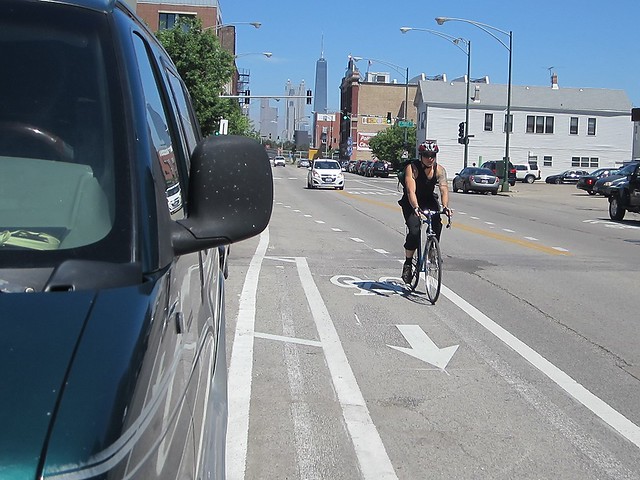
A buffered bike lane does a better job of encouraging bicyclists to ride outside the door zone than a wide bike lane. Photo: John Greenfield
According to the National Association of City Transportation Officials (NACTO), "Buffered bike lanes are conventional bicycle lanes paired with a designated buffer space separating the bicycle lane from the adjacent motor vehicle travel lane and/or parking lane."
"Chicago has been installing protected and buffered bike lanes across the city, and adding buffers to many conventional lanes," writes Vance.
If there’s enough space to make a wider bike lane, the authors conclude, that extra space should be used to install a “narrower bicycle lane with a parking-side buffer,” which “provides distinct advantages over a wider bike lane with no buffer.”
As the NACTO definition indicates, the buffer can also be placed between the curb lane and the bike lane, in lieu of or in addition to the parking lane, as shown in this Chicago photo, also by John Greenfield.
Looking south on Halsted, north of Fullerton. Photo: John Greenfield
FULL STORY: Study: To Keep Bicyclists Outside the Door Zone, You Need a Buffer

National Parks Layoffs Will Cause Communities to Lose Billions
Thousands of essential park workers were laid off this week, just before the busy spring break season.

Retro-silient?: America’s First “Eco-burb,” The Woodlands Turns 50
A master-planned community north of Houston offers lessons on green infrastructure and resilient design, but falls short of its founder’s lofty affordability and walkability goals.

Delivering for America Plan Will Downgrade Mail Service in at Least 49.5 Percent of Zip Codes
Republican and Democrat lawmakers criticize the plan for its disproportionate negative impact on rural communities.

Test News Post 1
This is a summary

Test News Headline 46
Test for the image on the front page.

Balancing Bombs and Butterflies: How the National Guard Protects a Rare Species
The National Guard at Fort Indiantown Gap uses GIS technology and land management strategies to balance military training with conservation efforts, ensuring the survival of the rare eastern regal fritillary butterfly.
Urban Design for Planners 1: Software Tools
This six-course series explores essential urban design concepts using open source software and equips planners with the tools they need to participate fully in the urban design process.
Planning for Universal Design
Learn the tools for implementing Universal Design in planning regulations.
EMC Planning Group, Inc.
Planetizen
Planetizen
Mpact (formerly Rail~Volution)
Great Falls Development Authority, Inc.
HUDs Office of Policy Development and Research
NYU Wagner Graduate School of Public Service

























